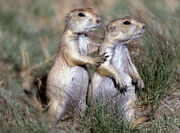
Kin Selection
Kin Selection: Traits being favored because the beneficial effects on survival of relatives-including offspring and offspring of closely related individuals.
The modern version of this theory was stated by Haldane in 1932 and expanded in 1955. He stated that an individual’s genes could still be passed on even when that individual never reproduced if the individual’s actions helped the reproduction and survival of relatives (such as siblings, nieces/nephews, etc.) (Wilson, E. O., 2005).
Altruism and Kin Selection[]
This theory helps to explain some altruistic behaviors in animals. It explains how an individual may sacrifice its own survival goals (passing on genes) to help another survive (or pass on their genes). Hamilton’s rule places this into a mathematical inequality: rb-c>0 where r is relatedness of the individuals, b is the benefit of the act for the recipient and c is the cost of the act for the actor. (Griffin & West, 2002).
Prairie dogs may serve as an example of a species that is thought to display altruistic behaviors. Prairie dogs live in large “towns” which sometimes span hundreds of acres and can house millions of individuals (National Geographic, n.d.). Often individual prairie dogs will sound alarm calls in situations of imposin

g danger (McGraw-Hill, n.d.). Obviously, this is altruistic in the sense that the individual puts itself at greater risk; what seems less clear, however, is whether this behavior evolved as a function to support kin, with other non-related neighbors just happening to benefit by default, or if it might be, as Trivers (1971) suggests, a form of reciprocal altruism in which the individual puts itself in a position of danger with the hope that this service might be returned at some point in the future.
There are those who do not believe kin selection explains altruism, including E.O.Wilson. Wilson has stated that Hamilton’s theory is incorrect due to three mistakes and assumptions. Hamilton’s theory was based on observations of colonial insects, such as ants, termites and wasps. Wilson writes how altruism in these animals can be due to other factors besides kin selection. He also states how altruism can happen even between non-related individuals (Wilson, E. O., 2005).
Foster, Weneseleers and Fatnieks (2006) have written to explain how Wilson misunderstands kin selection. So it would seem kin selection is part of evolutionary biology, but not all biologist accept it as they accept natural selection.
References[]
Foster, K. R., Wenseleers, T., & Ratnieks, F. L. (2006). Kin selection is the key to altruism. Trends in Ecology & Evolution, 21(2), 57-60.
Griffin, A. S., & West, S. A. (2002). Kin selection: fact and fiction. Trends in Ecology & Evolution, 17(1), 15-21.
=McGraw-Hill (n.d). Altruism and Sociality. Retrieved from: http://www.mhhe.com/biosci/esp/2001_gbio/folder_structure/an/m14/s9/index.htm =
National Geographic (n.d.). Prairie Dog Cynomys ludovicianus. Retrieved from: http://animals.nationalgeographic.com/animals/mammals/prairie-dog/
Wilson, E. O. (2005). Kin selection as the key to altruism: its rise and fall.Social Research: An International Quarterly, 72(1), 1-8.